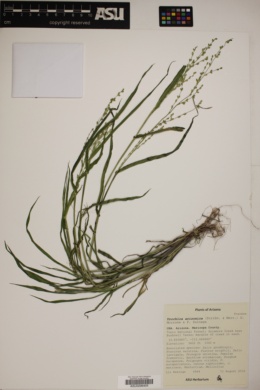Urochloa arizonica
|
Urochloa arizonica (Scribn. & Merr.) O. Morrone & F. Zuloaga
 (redirected from: Panicum fuscum var. major Vasey) (redirected from: Panicum fuscum var. major Vasey) |
|
|
Family: Poaceae
Arizona Liverseed Grass, more...Arizona signalgrass, Arizona panicgrass
[Brachiaria arizonica (Scribn. & Merr.) S.T. Blake, moreBrachiaria arizonica var. laeviglumis (Scribn. & Merr.) Beetle, Brachiaria arizonica var. major (Vasey) Beetle, Brachiaria arizonica var. tenuis (Scribn. & Merr.) Beetle, Panicum arizonicum Scribn. & Merr., Panicum arizonicum var. arizonicum Scribn. & Merr., Panicum arizonicum var. laeviglume Scribn. & Merr., Panicum arizonicum var. majus (Vasey) Scribn. & Merr., Panicum arizonicum var. tenue Scribn. & Merr., Panicum fasciculatum var. dissitiflorum Vasey ex Scribn. & Merr., Panicum fasciculatum var. majus (Vasey) Beal, Panicum fuscum var. major Vasey] |
Plants annual. Culms 15-65 cm, erect or geniculate, branching from the lower nodes; nodes glabrous or hispid. Sheaths glabrous or with papillose-based hairs, margins ciliate distally; ligules 1-1.6 mm; blades 5-15 cm long, 5-12 mm wide, glabrous. Panicles 6-20 cm long, 2-5 cm wide, ovoid, with 6-12 spikelike primary branches in more than 2 ranks; primary branches 3-7 cm, divergent, axes about 0.4 mm wide, triquetrous, densely pubescent with papillose-based hairs; secondary branches short, divergent; pedicels shorter than the spikelets, with papillose-based hairs. Spikelets 3.2-4 mm long, 1.2-1.6 mm wide, mostly paired, in 2 rows, appressed to the branches. Glumes scarcely separate, rachilla internodes short, not pronounced; lower glumes 1.5-2 mm, to 1/2 as long as the spikelets, glabrous, 5-veined, sometimes with evident cross venation near the apices; upper glumes 2.5-3.2 mm, glabrous or shortly hirsute, 7-veined, with evident cross venation distally; lower florets staminate or sterile; lower lemmas 2.5-3.2 mm, glabrous or shortly hirsute, 5-veined, about as long as the spikelet; lower paleas present; upper lemmas 2.8-3 mm long, 1.2-1.6 mm wide, acute, beaked or mucronate; anthers 0.8-1 mm. Caryopses 1.5-2 mm; hila punctiform. 2n = 36. Urochloa arizonica is native to the southwestern United States and northern Mexico, but has been introduced and appears to be established in the southeastern United States. It grows in open, dry areas with rocky or sandy soils. Dr. David Bogler: USDA NRCS PLANTS Database Annuals, Terrestrial, not aquatic, Stems nodes swollen or brittle, Stems geniculate, decumbent, or lax, sometimes rooting at nodes, Stems caespitose, tufted, or clustered, Stems terete, round in cross section, or polygonal, Stems branching above base or distally at nodes, Stem nodes bearded or hairy, Stem internodes hollow, Stems with inflorescence less than 1 m tall, Stems, culms, or scapes exceeding basal leaves, Leaves mostly cauline, Leaves conspicuously 2-ranked, distichous, Leaves sheathing at base, Leaf sheath mostly open, or loose, Leaf sheath smooth, glabrous, Leaf sheath hairy, hispid or prickly, Leaf sheath and blade differentiated, Leaf blades lanceolate, Leaf blades 2-10 mm wide, Leaf blades mostly flat, Leaf blades mostly glabrous, Leaf blades more or less hairy, Ligule present, Ligule a fringed, ciliate, or lobed membrane, Inflorescence terminal, Inflorescence solitary, with 1 spike, fascicle, glomerule, head, or cluster per stem or culm, Inflorescence a panicle with narrowly racemose or spicate branches, Inflorescence with 2-10 branches, Inflorescence branches 1-sided, Peduncle or rachis scabrous or pubescent, often with long hairs, Rachis angular, Flowers bisexual, Spikelets pedicellate, Spikelets sessile or subsessile, Spikelets dorsally compressed or terete, Spikelet less than 3 mm wide, Spikelets with 1 fertile floret, Spikelets with 2 florets, Spikelet with 1 fertile floret and 1-2 sterile florets, Spikelets solitary at rachis nodes, Spikelets all alike and fertille, Spikelets in paired units, 1 sessile, 1 pedicellate, Spikelets bisexual, Spikelets disarticulating below the glumes, Spikelets secund, in rows on one side of rachis, Rachi lla or pedicel glabrous, Glumes present, empty bracts, Glumes 2 clearly present, Glumes distinctly unequal, Glumes equal to or longer than adjacent lemma, Glumes 4-7 nerved, Lemma coriaceous, firmer or thicker in texture than the glumes, Lemma becoming indurate, enclosing palea and caryopsis, Lemma 5-7 nerved, Lemma glabrous, Lemma rugose, with cross wrinkles, or roughened, Lemma apex acute or acuminate, Lemma awnless, Lemma straight, Palea present, well developed, Palea longer than lemma, Stamens 3, Styles 2-fid, deeply 2-branched, Stigmas 2, Fruit - caryopsis.
FNA 2003, Gould 1988 Common Name: Arizona signalgrass Duration: Annual Nativity: Native Lifeform: Graminoid General: Annual grass, 15-60 cm tall; stems erect or geniculate, much-branched at the lower nodes, glabrous or sparsely hispid at the nodes and below the panicle. Vegetative: Sheaths glabrous to papillose-hispid, loose; blades 5-15 mm broad, glabrous or scabrous, ciliate on margins at least near the base; ligules 1-1.5 mm. Inflorescence: Panicle 7-20 cm long with appressed or erect-spreading hairs, branches scabrous; pedicels 1-3 mm long, paired, appressed, glabrous or pubescent; spikelets mostly 3-4 mm long, 2-flowered, the first floret reduced to a sterile lemma and the second floret fertile; first glume half or slightly less as long as the spikelet; second glume and sterile lemma puberulent or glabrous, abruptly pointed at apex; fertile lemma indurate, reticulate or finely rugose, abruptly short-beaked or cuspidate, 2-3 mm long. Ecology: Found on sandy ground, rocky slopes, and canyon bottoms from 1,000-5,500 ft (457-1676 m); flowers June-October. Distribution: s CA, AZ, s NM, s TX; south to s MEX. Notes: Formerly recognized as Panicum, this annual grass has the hard, single-seeded spikelets that define that group. Distinguish from annuals Panicum capillare and P. hirticaule by the fertile lemmas which are not smooth and shiny but have wrinkles or reticulation. To distinguish from from B. fusca look for the presence of enlarged bases of hairs on inflorescence branches. Also distinguished by having broad, ciliate flag leaves. Ethnobotany: Unknown Etymology: Brachiaria from the Latin brachium, arm, alluding to the arm-like racemes (more obvious in other species of the genus); arizonica refers to Arizona. Synonyms: Brachiaria arizonica, Panicum arizonicum, Urochloa arizonica Editor: SBuckley 2010, FSCoburn 2015, AHazelton 2015 |
|
|
|
































































































